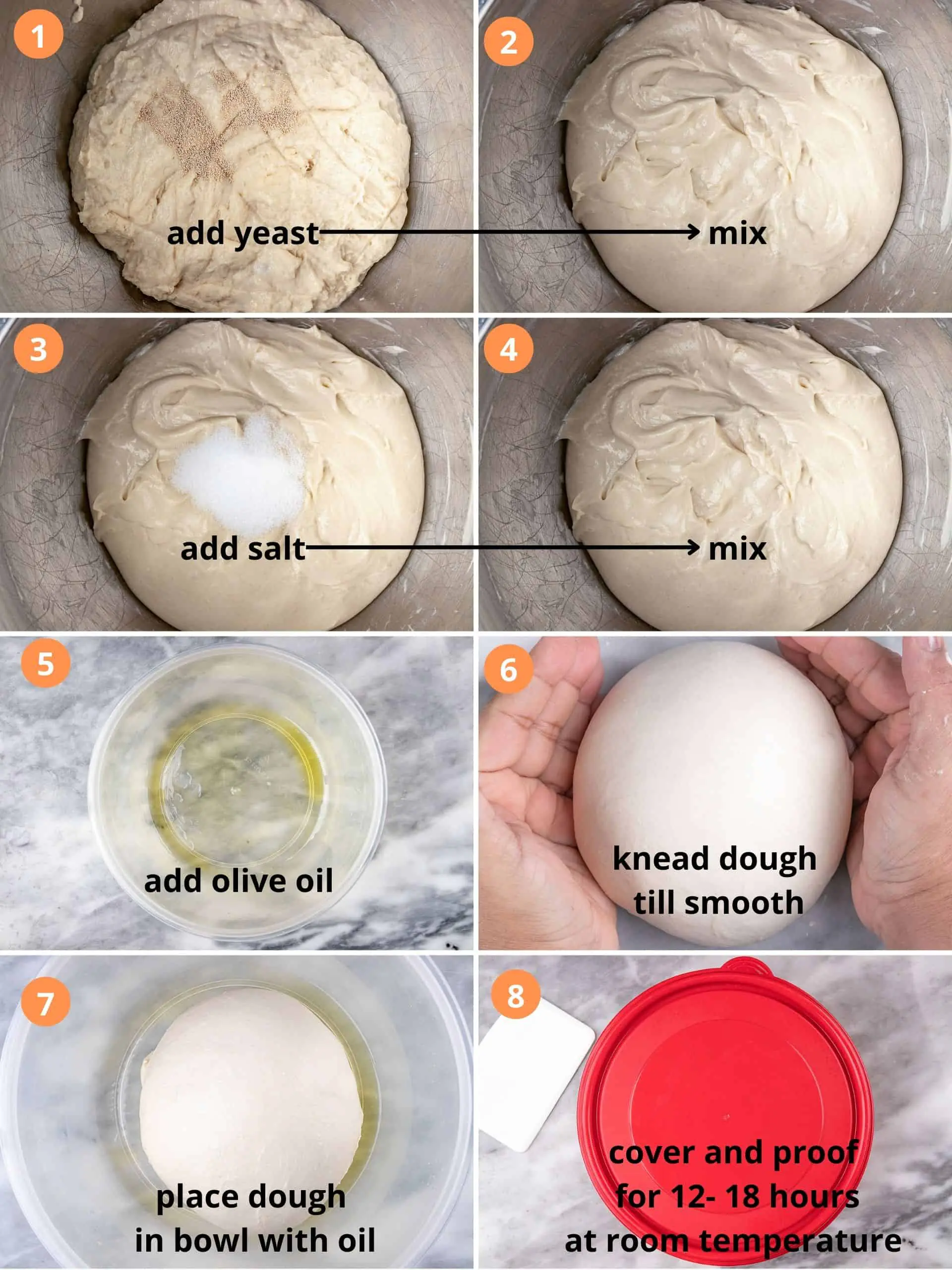How long should you let pizza dough rise? Pizza dough should typically rise for at least 1 to 1.5 hours. For the best flavor and texture, a slow rise in the refrigerator overnight is ideal.
Crafting the perfect pizza begins long before it hits the oven; it starts with the patience and artistry of letting your dough rise. Achieving that mouthwatering fluffiness and chew depends largely on fermentation time. A dough’s rise is a critical phase, allowing yeast to work its magic, creating gases that contribute to the dough’s volume and taste.
Time and temperature play pivotal roles in this process, and understanding their impact will elevate your homemade pizza to pizzeria quality. The right rise time gives the crust its signature airy pockets and provides a canvas for toppings to nestle into as it bakes to golden perfection. Let’s dive into the essentials of nailing the dough rise for that impeccable homemade pizza.
Rising Dough: A Critical Step For Perfect Pizza
The secret to a delicious, airy pizza crust lies in the rise. Yeast works its magic, creating a light and flavorful dough. Miss this step, and you risk a flat, tough pizza. Let’s learn how dough should rise to achieve pizza perfection.
The Role Of Yeast In Dough Rising
Yeast is the star in dough rising. It feeds on sugars, releasing carbon dioxide and alcohol. This process, called fermentation, expands the dough. The result? A soft, chewy crust that’s a delight in every bite.
- Optimal Temperature: Yeast thrives at 75-85°F (24-29°C).
- Time Matters: Dough usually needs 1-2 hours to rise properly.
Factors Affecting The Rising Process
Several elements influence how the dough rises. Temperature and ingredients top the list. Controlling these factors ensures a consistent rise every time.
| Factor | Impact on Dough Rising |
| Temperature | Warmth speeds up yeast activity. Cold slows it down. |
| Ingredients | Flour quality, water, and sugar amounts can affect the rise. |
| Time | Longer rise can mean more flavor and better texture. |

Credit: papasprimopizza.com
Quick Rise Vs. Slow Fermentation
Let’s explore the art of pizza dough creation. Two popular methods exist: quick rise and slow fermentation. Each brings unique qualities to your pizza.
Advantages Of A Quick Rise
Time-saving is a clear benefit here. Are you eager to enjoy homemade pizza tonight? Quick rise is your go-to.
- Faster yeast activity: Warm environments speed up yeast growth.
- Ready in an hour: The dough doubles in size rapidly.
- Good for busy schedules: It fits in a tight schedule.
A quick rise only needs some day. Active dry yeast works well. Please put it in a warm place. Watch it expand in no time. You’ll be shaping your pizza base before you know it!
Benefits Of Slow Fermentation
Slow fermentation is about patience and flavor. Cold fermentation in the fridge can take from 24 hours up to 3 days. Here’s why it’s great:
| Feature | Benefit |
| Developed flavors | Complex, enhanced taste! |
| Better texture | Chewy and airy crust. |
| Digestibility | More time for gluten to break down. |
With slow fermentation, the dough’s taste and texture improve. Cool temperatures slow down the yeast, and complex flavors build over time. Also, the longer rise can make the crust easier to digest. Choose this for a gourmet experience.
The Science Of Time And Taste
Mastering the art of pizza dough requires understanding time and taste. The dough’s rise isn’t just a waiting game; it’s a transformation. Yeast works magic, altering texture and flavor. This process isn’t just about growth; it’s about reaching the peak of deliciousness. When the dough rises, texture and taste align, promising a better bite. Let’s dive into what happens during this crucial time.
Flavor Development Over Time
Pizza dough’s flavor deepens as it rises. Yeast ferments sugar in flour, creating alcohol and carbon dioxide. This fermentation gives dough its distinct taste. A longer rise equals more flavor complexity. Fine pizza boasts nuanced flavor layers; a slow rise is the secret.
Here’s a quick look at timeframes for taste evolution in pizza dough:
- 0-2 hours: Basic flavors, fresh tones.
- 2-24 hours: Enhanced tastes, richer experience.
- Over 24 hours: Bold, well-developed profiles.
Gluten Formation And Digestibility
Gluten, a protein web, gives dough elasticity and strength. Time impacts this network. Initially, gluten is rough. As the dough rises, it becomes fine-tuned, leading to the perfect chew. This time also impacts how we digest pizza. Longer rises to break down gluten, aiding digestion.
Here’s how the gluten evolves:
| Time | Gluten Quality | Digestibility |
| 1-2 hours | Developing | Standard |
| 6-8 hours | Strengthening | Improved |
| 12+ hours | Optimized | Enhanced |
Be mindful that overly long fermentation can result in overproofing, which deflates the dough. Balancing time is key to the perfect pizza dough.

Credit: belgianfoodie.com
Room Temperature Rising Secrets
Let’s unlock the secrets to the perfect pizza dough rise at room temperature. This process, often known as proofing, is crucial. It can make or break your homemade pizza. Understand the magic behind letting your dough rise just right, and never look back!
Ideal Conditions For Room Temperature Proofing
Creating the ideal environment for dough to rise is simpler than you might think. It doesn’t need much: a cozy spot with a consistent temperature is enough. Room temperature is perfect for proofing dough, but the term ‘room temperature’ can vary. Aim for a stable environment between 68-75°F (20-24°C). This range ensures the yeast works efficiently, creating a light and flavorful crust.
- Avoid drafts: Keep dough away from windows or doors.
- Cover the dough: Use a damp cloth or plastic wrap.
- Give it time: Rushing can result in underproofed dough.
Timing Tips For Warmer Climates
In warmer climates, dough rises faster due to higher temperatures. Here’s how to adjust:
- Shorten the rise time: High heat speeds up yeast activity.
- Find a cooler spot: Perhaps a pantry or a shaded area.
- Monitor the dough’s growth: It should double in size, not more.
Use these tips to keep your proofing process on track, even when the mercury rises. A watchful eye ensures that dough doesn’t overproof, keeping textures and tastes on point. Let’s turn that simple mixture of flour, water, yeast, and salt into the star of your home-cooked meal!
Cold Fermentation: The Refrigerator Method
When it comes to pizza dough, time is a secret ingredient. ‘Cold fermentation’ uses your refrigerator to create wonderful flavors. This method extends the dough’s rise. It is a simple trick for a delicious pizza base. Let’s explore the chilled path to a tastier crust.
Extending The Rise For Depth Of Flavor
Longer rises transform the dough. Aromatic compounds develop, and textures become more intricate. This method unlocks a complex taste profile. Cold fermentation means your dough can rise for 24 to 72 hours. Aim for longer periods for richer flavors. With patience, the result is a crust that’s both flavorful and sumptuous.
How Refrigerator Temperature Affects Yeast Activity
In your fridge, yeast works slowly. It still enhances your dough but at a leisurely pace. The cool temperatures slow down fermentation. This gentle rise does magic, balancing rise and flavor. Typical fridge settings range from 35°F to 38°F (1.7°C to 3.3°C). Keep your dough within this range for optimal results.
| Temperature | Yeast Activity | Recommended Rise Time |
| 35°F (1.7°C) | Minimal | 48-72 hours |
| 38°F (3.3°C) | Moderate | 24-48 hours |
Remember, the key is consistency. Your fridge keeps the temperature stable, allowing the dough to ferment without rushing. Keep an eye on the rise. Expect a gradual increase in size. Ensure your bowl is big enough to prevent overflow.
Always cover your dough. Use plastic wrap or a damp towel to avoid drying out the surface. Enjoy the journey to gourmet pizza at home with cold fermentation.
Visual And Tactile Cues For Perfect Rise
Letting pizza dough rise is an art form. Achieving the perfect rise is crucial for that delicious, airy crust. Visual and tactile cues help home bakers nail the rise every time. Keep an eye out for changes in size and surface as well as texture. These indicators will steer you right.
Size And Surface Indicators
- Doubles in size: Ideal pizza dough should almost double.
- Smooth and slightly puffy: The dough’s transformation is visible.
Soft visual signs hint at the dough’s readiness. Is it puffing up? That’s yeast working its magic. Dough that has yet to budge lacks proper rise. A surface that’s gotten smooth and slightly rounded at the top is a green light. It indicates the dough is expanding as it should.
Textural Changes In Risen Dough
- Soft and springy: The dough feels alive under a gentle press.
- Leaves an impression: If a pressed fingertip leaves a mark, that’s good.
When given a gentle press, perfectly risen dough will bounce back slightly. If pressing leaves a dent that stays, the dough is over-proofed. A soft, pillowy texture means yeast has done its job. Poke it, and your fingertip should leave a subtle impression. It is too firm, and it needs more time; if it collapses, it’s over-proofed.
Troubleshooting Common Rising Issues
Getting your pizza dough to rise perfectly can be tricky. Sometimes, the dough will puff up differently than expected. Other times, it may overproof and affect your pizza’s texture. Let’s face it: Everyone wants that perfect rise for the perfect crust. Don’t worry if you’re facing these issues; there are ways to fix them! Below, we’ll tackle the common challenges when letting pizza dough rise and provide solutions to get your pizza crust back on track.
Dough That Won’t Rise
It’s frustrating when pizza dough doesn’t rise. It often comes down to the yeast. If the yeast is too old or dead, the dough remains flat. Be sure your yeast is fresh. Use warm water to activate it. But not too hot, or it will kill the yeast. The ideal temperature is between 105-110°F. Another reason could be your kitchen’s temperature. Yeast thrives in a warm environment. If your kitchen is too cool, find a warmer spot or create a cozy environment in your oven with just the light on.
- Check the use-by date on the yeast
- Use warm water (105-110°F), not hot
- Rise dough in a warm spot
Overproofed Dough: Recognizing And Salvaging
Letting the dough rise for too long makes it over-proofed. Overproofed dough is often flat and deflated. Please don’t fret; it can be saved. First, recognize the signs. If the dough is very airy, smells of alcohol, or collapses with a poke, it’s over-proofed. To salvage, reshape the dough and let it rise for a short time before baking. Keeping an eye on the rise and setting a timer can prevent overproofing.
| Signs of Overproofing | Solutions |
| Airy and flat dough | Reshape and re-rise briefly. |
| Alcoholic odor | Shorter second rise time |
| The dough collapses with a poke. | Proof for less time |
Making pizza at home can lead to delicious results. If you need help with your dough, use these tips. With practice, you’ll become a dough-raising expert. Enjoy that wonderful rise and bake the perfect pizza!

Credit: www.reddit.com
Practical Timing Guide For Pizza Dough Rise
Lovers of homemade pizza know the importance of perfect dough. But how long should pizza dough rise? This Practical Timing Guide breaks down the rising process to ensure a delicious base for your toppings.
Recommended Times For Various Styles
Different pizzas need different rising times. A glance at times for various pizza styles helps you plan.
Table Representation for Different Styles
| Pizza Style | First Rise | Second Rise (If applicable) |
| Neapolitan | 8-12 hours | 2 hours at room temp |
| New York-style | 1-1.5 hours | NA |
| Deep Dish | 1-1.5 hours | NA |
| Sicilian | 2 hours | NA |
Specialty pizzas, like a sourdough base, may require up to 24 hours!
Adjusting Rise Times For Schedules And Taste
Dough rise can fit into your day. Use cold fermentation for a slower rise, while warm environments speed up the process.
Bullet Points for Adjusting Rise Times
- Slow Rise: Refrigerate for 24-72 hours and develop flavor.
- Standard Rise: 1-1.5 hours at room temperature; doubles in size.
- Quick Rise: Use more yeast; the dough is ready in 30 minutes.
Experiment with times to find the taste and texture you love. Enjoy crafting the perfect homemade pizza dough!
Frequently Asked Questions
Can You Let Pizza Dough Rise For Too Long?
Yes, letting pizza dough rise for too long can lead to overfermentation, which negatively affects flavor and texture. Aim for the recommended rise time for best results.
How Long Should Pizza Dough Sit Before Using?
Pizza dough should ideally rest for at least 30 minutes to 1 hour before using. This allows the gluten to relax and the dough to rise, resulting in a better texture.
How Long Do You Let Store-bought Pizza Dough Rise?
For best results, let store-bought pizza dough rise for about 30 minutes to 1 hour at room temperature before baking.
How Long Can You Let Dough Rise At Room Temperature?
Dough typically rises well at room temperature for 2 to 4 hours. Beyond this, it can overproof, affecting texture and flavor.
Conclusion
Understanding the ideal rise time for pizza dough is key to perfecting your homemade pizza. Aim for at least 1 to 1. 5 hours, allowing the yeast to work its magic—factor in your kitchen’s temperature for the best results.
Remember, patience rewards you with delicious pizza every time. Happy baking!

As the author of the “Ultimate Pizza Guide: Recipes, Tips & Secrets Revealed,” I’m dedicated to sharing my love for pizza and empowering others to create delicious homemade pizzas with ease. Join me on a journey to uncover the secrets to perfecting your pizza game!



